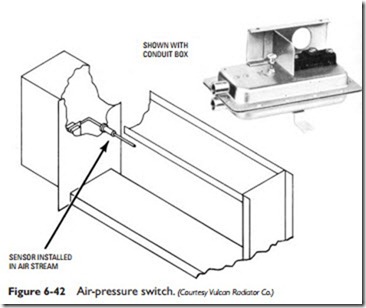Pressure Switches
A pressure switch is a safety device designed to stop or start heating or air-conditioning equipment in response to gas- or air-pressure changes. These switches are used in either positive-pressure or differential-pressure systems.
Gas-pressure switches used in the control of gas-fired furnaces and boilers are described in the section Pressure Switches in Chapter 5 (Gas and Oil Controls). Pressure switches used as refrigerant controllers in a cooling system are described in this chapter (see Low- Pressure Cutout Switch and High-Pressure Cutout Switch).
The National Electrical Code requires that a duct heater be inter- locked with the system fan so that the heater cannot be energized unless the fan is also energized. This can be accomplished by using either a fan interlock relay or a built-in air-pressure switch.
An air-pressure switch designed to provide fan interlock control consists of an internal diaphragm that is actuated by positive air pressure. The switch sensor is mounted so that it extends into the air stream (see Figure 6-42). Movement of the diaphragm closes an electrical switch, which permits the duct heater to turn on. When there is no airflow or low airflow, the switch will open and turn off the duct heater.
